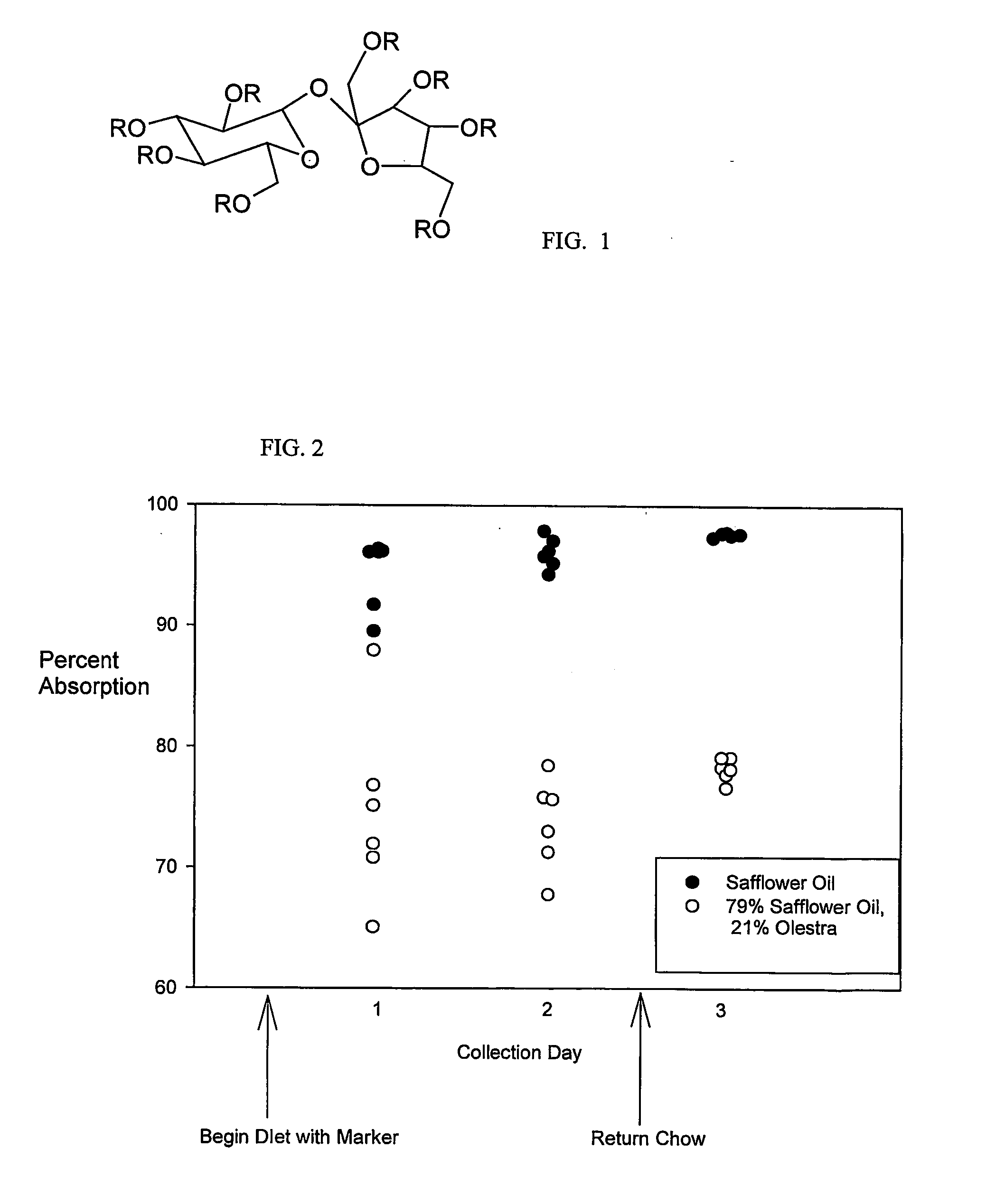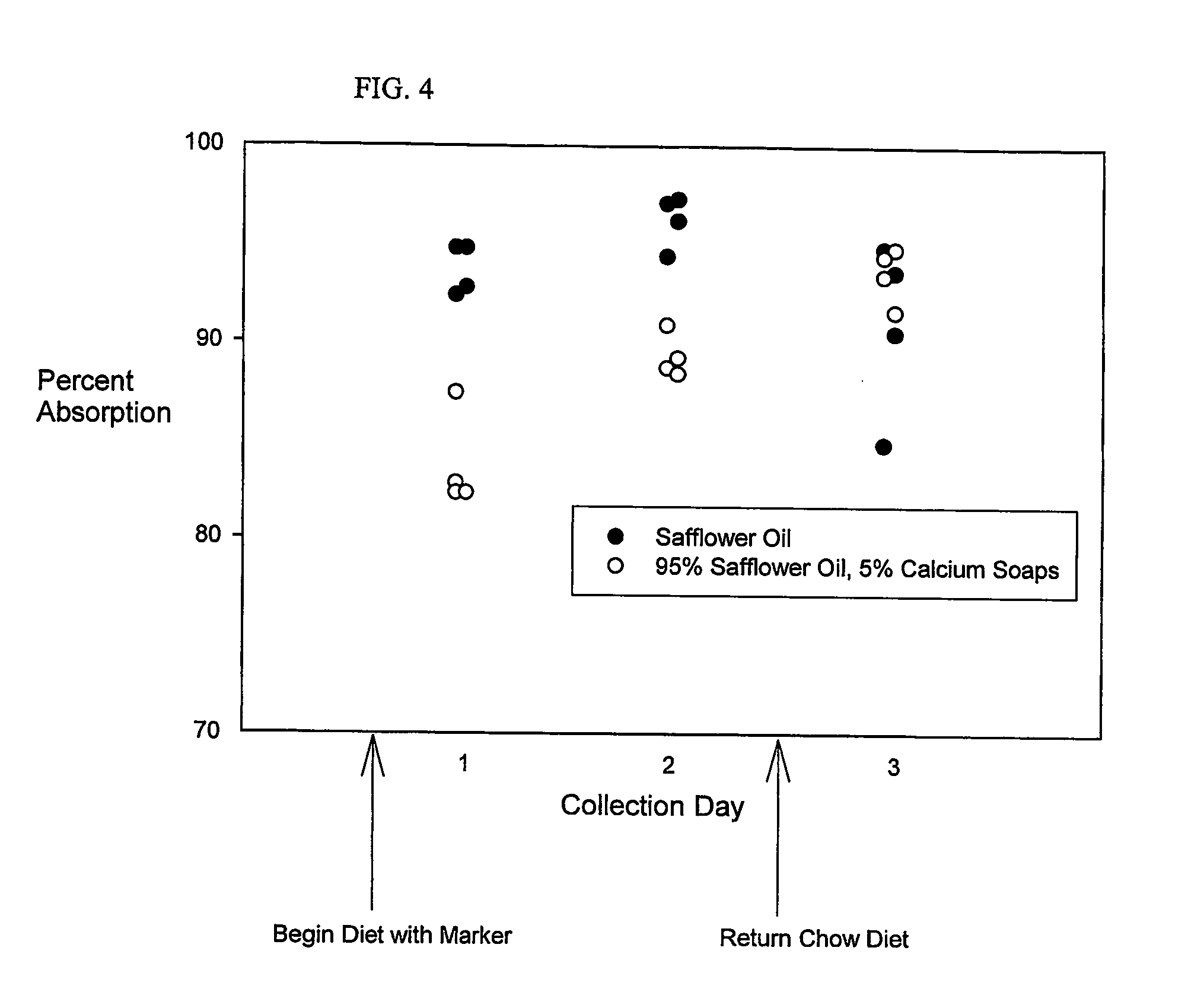Use of non-absorbable fat in determining dietary fat absorption
a non-absorbable fat and dietary fat technology, applied in the field of fecal analysis, can solve the problems of linear growth failure, significant weight retardation, energy imbalance, etc., and achieve the effect of constant ratio
- Summary
- Abstract
- Description
- Claims
- Application Information
AI Technical Summary
Benefits of technology
Problems solved by technology
Method used
Image
Examples
example 1
[0058] Fat absorption from the Safflower Oil Diet and the Safflower Oil and Olestra Diet is compared in C57B1 / 6 male mice at least 5 weeks of age. Three mice housed in a first cage receive the Safflower Oil Diet, and three mice housed in a second cage receive the Safflower Oil and Olestra Diet. Essentially all of the feces from the second day's collection (after two days in which the animals received the test diet) are light in color. This appearance contrasts with the collections after the first day of feeding, in which approximately equal amounts of dark and light fecal pellets appeared. On the third collection day, most of the feces are dark in appearance. Intact single fecal pellets from mice (6-29 mg) are analyzed using the Fat Extraction and Gas Chromatography Protocols. Corresponding with transit of the diets through the gut, the darker feces contain only traces of behenic acid. Therefore, only the values obtained from light-colored fecal pellets are considered for calculatio...
example 2
[0062] Fat absorption is measured in two rats fed the Safflower Oil Diet, and two rats fed the Safflower Oil and Olestra Diet. The rats are housed in individual cages. As noted in Example 1, the feces following the second day of test diet are all light in appearance. The feces following the first day are essentially all dark in appearance, as are those from the third collection period, which follows the return to chow. Based on findings in Example 1, light colored fecal pellets were selected for analysis. Approximately 10 mg of randomly sampled portions of feces from rats were used for sample preparation and analysis, using the Fat Extraction and Gas Chromatography Protocols. The Fat / Marker Recovery Calculation is used to indirectly calculate the amount of fat absorbed from the test diets. The absorption is calculated to be 95.4±0.5% (mean±SEM) of that which was fed, based on the 14 fecal samples that are collected over the 3 days, shown in FIG. 3. Based on the values from the fecal...
example 3
[0063] Fat absorption is measured in three C57B1 / 6 female mice at 5 weeks of age that are provided with the Safflower Oil Diet, and three that are provided with the Safflower Oil and Calcium Soaps Diet. The appearance of the feces follows a pattern similar to that seen in Examples 1 and 2. Essentially all feces are dark in appearance in the first collection, all are light in the second collection, and all are mostly dark in the third collection. Four light colored samples are analyzed, using the Fat Extraction and Gas Chromatography Protocols. The Fat / Marker Recovery Calculation is used to indirectly calculate the amount of fat absorbed from the test meals. Results are shown in FIG. 4. The total fatty acid absorption for animals being fed the Safflower Oil Diet is similar to that of the examples described above—94-97% (96.3±0.7%, mean and standard error) based on the collection on Day 2, and the total fatty acid absorption by the group fed the Safflower Oil and Calcium Soaps Diet ra...
PUM
 Login to View More
Login to View More Abstract
Description
Claims
Application Information
 Login to View More
Login to View More - R&D
- Intellectual Property
- Life Sciences
- Materials
- Tech Scout
- Unparalleled Data Quality
- Higher Quality Content
- 60% Fewer Hallucinations
Browse by: Latest US Patents, China's latest patents, Technical Efficacy Thesaurus, Application Domain, Technology Topic, Popular Technical Reports.
© 2025 PatSnap. All rights reserved.Legal|Privacy policy|Modern Slavery Act Transparency Statement|Sitemap|About US| Contact US: help@patsnap.com



